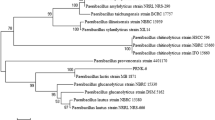Abstract
A Mycobacterium sp. isolated from oil-contaminated sediments was previously shown to mineralize 55% of the added naphthalene to carbon dioxide after 7 days of incubation. In this paper, we report the initial steps of the degradation of naphthalene by a Mycobacterium sp. as determined by isolation of metabolites and incorporation of oxygen from 18O2 into the metabolites. The results indicate that naphthalene is initially converted to cis- and trans-1,2-dihydroxy-1,2-dihydronaphthalene by dioxygenase and monooxygenase catalyzed reactions, respectively. The ratio of the cis to trans-naphthalene dihydrodiol isomers was approximately 25:1. Thin layer and high pressure liquid chromatographic and mass spectrometric techniques indicated that besides the cis- and trans-1,2-dihydroxy-1,2-dihydronaphthalene, minor amounts of ring cleavage products salicylate and catechol were also formed. Thus the formation of both cis and trans-naphthalene dihydrodiols by the Mycobacterium sp. is unique. The down-stream reactions to ring cleavage products proceed through analogous dioxygenase reactions previously reported for the bacterial degradation of naphthalene.
Similar content being viewed by others
References
Cerniglia CE (1984) Microbial metabolism of polycyclic aromatic hydrocarbons. Advances Appl. Microbiol. 30: 31–71
Cerniglia CE, Althaus JR, Evans FE, Freeman JP, Mitchum RK & Yang SK (1983) Stereochemistry and evidence for an arene oxide-NIH shift pathway in the fungal metabolism of naphthalene. Chem.-Biol. Interactions 44: 119–132
Cerniglia CE & Gibson DT (1977) Metabolism of naphthalene by Cunninghamella elegans. Appl. Environ. Microbiol. 34: 363–370
Cerniglia CE (1978) Metabolism of naphthalene by cell extracts of Cunninghamella elegans. Arch. Biochem. Biophys. 186: 121–127
Cerniglia CE, Herbert RL, Szaniszlo PJ & Gibson DT (1978) Fungal transformation of naphthalene. Arch. Microbiol. 117: 135–143
Davies JI & Evans WC (1964) Oxidative metabolism of naphthalene by soil pseudomonads. Biochem. J. 91: 251–261
Gibson DT & Subramanian V (1984) Microbial, degradation of aromatic hydrocarbons. In: Gibson DT (Ed) Microbial Degradation of Organic Compounds (pp 181–252). Marcel Dekker, New York
Grimmer G & Pott F (1983) Occurrence of PAH. In: Grimmer G (Ed) Environmental Carcinogens: Polycyclic Aromatic Hydrocarbons (pp 61–128). CRC Press, Boca Raton, FL
Groenewegen D & Stolp H (1976) Mikrobieller Abbau von polyzyklischen aromatischen Kohlenwasserstoffen. Zentralbl. Bakteriol. 162: 225–232
Heitkamp MA & Cerniglia CE (1989) Microbial degradation of polycyclic aromatic hydrocarbons in the aquatic environment. In: Varanasi U (Ed) Metabolism of Polycyclic Aromatic Hydrocarbons in the Aquatic Environment (pp 41–68). CRC Press, Boca Raton, Florida
Heitkamp MA (1986) Microbial degradation of tert-butylphenyl diphenyl phosphate: A comparative microcosm study among five diverse ecosystems. Toxicity Assessment Bulletin 1: 103–122
Heitkamp MA (1988) Mineralization of polycyclic aromatic hydrocarbons by a bacterium isolated from sediment below an oil field. Appl. Environ. Microbiol. 54: 1612–1614
Heitkamp MA (1989) Polycyclic aromatic hydrocarbon degradation by a Mycobacterium sp. in microcosms containing sediment and water from a pristine ecosystem. Appl. Environ. Microbiol. 55: 1968–1973
Heitkamp MA, Franklin W & Cerniglia CE (1988) Microbial metabolism of polycyclic aromatic hydrocarbons: Isolation and characterization of a pyrene-degrading bacterium. Appl. Environ. Microbiol. 54: 2549–2555
Heitkamp MA, Freeman JP & Cerniglia CE (1987) Naphthalene biodegradation in environmental microcosms: Estimates of degradation rates and characterization of metabolites. Appl. Environ. Microbiol. 53: 129–136
Heitkamp MA, Freeman JP, Miller DW & Cerniglia CE (1988) Pyrene degradation by a Mycobacterium sp.: Identification of ring oxidation and ring fission products. Appl. Environ. Microbiol. 54: 2556–2565
Holder CL, Korfmacher WA, Slikker W, Thompson HC & Gosnell AB (1985) Mass spectral characterization of doxylamine and its rhesus monkey urinary metabolites. Biomed. Mass Spectrometry 12: 151–158
Huckins JN, Petty JD & Heitkamp MA (1984) Modular containers for microcosm and process model studies on the fate and effects of aquatic contaminants. Chemosphere 13: 1329–1341
Jeffrey AM, Yeh HJC, Jerina DM, Patel TR, Davey JF & Gibson DT (1975) Initial reaction of naphthalene by Pseudomonas putida. Biochemistry 14: 575–584
Jerina DM, Daly JW, Jeffrey AM & Gibson DT (1971) Cis-1,2-Dihydroxy-1,2-dihydronaphthalene: A bacterial metabolite from naphthalene. Arch. Biochem. Biophys. 142: 393–396
Kelley I & Cerniglia CE (1991) The metabolism of fluoranthene by a species of Mycobacterium. J. Ind. Microbiol. 1: 19–26
Sitting M (1985) Handbook of Toxic and Hazardous Chemicals and Carcinogens (pp 630–632). Noyes Publications, New Jersey
U.S. Environmental Protection Agency (1980A) Naphthalene: Ambient Water Quality Criteria. Wash. D.C.
U.S. Environmental Protection Agency (1980B) Naphthalene, Health and Environmental Effects Profile No. 131, Wash. D.C., Office of Solid Waste
Wackett LP, Kwart LD & Gibson DT (1988) Benzylic monooxygenation catalyzed by toluene dioxygenase from Pseudomonas putida. Biochem. 27: 1360–1367
Author information
Authors and Affiliations
Rights and permissions
About this article
Cite this article
Kelley, I., Freeman, J.P. & Cerniglia, C.E. Identification of metabolites from degradation of naphthalene by a Mycobacterium sp.. Biodegradation 1, 283–290 (1990). https://doi.org/10.1007/BF00119765
Received:
Accepted:
Issue Date:
DOI: https://doi.org/10.1007/BF00119765




